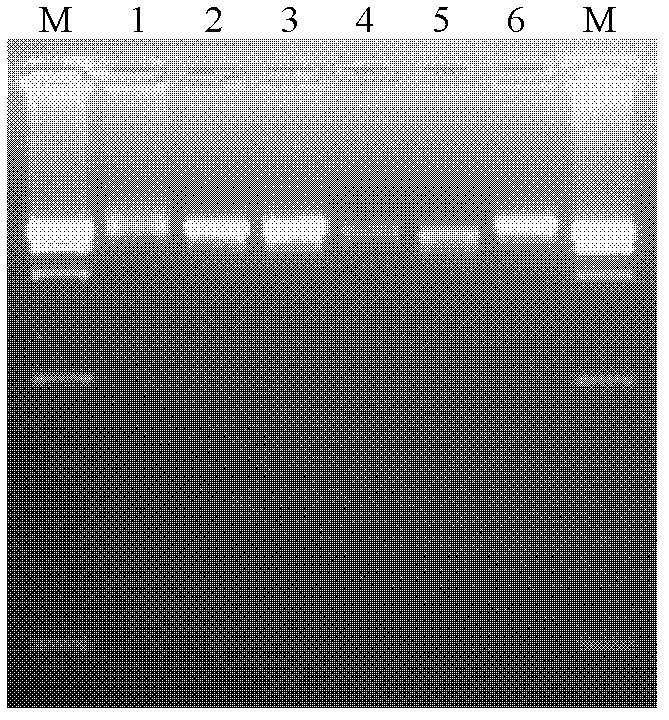PCR primer pair for identification or auxiliary identification of tissues and/or organs of mouse and applications thereof
A primer pair and mouse identification technology, which is applied in the determination/inspection of microorganisms, DNA/RNA fragments, recombinant DNA technology, etc., can solve the problems of complicated operation of DNA molecular hybridization, inability to detect heat-processed meat, and high cost.
- Summary
- Abstract
- Description
- Claims
- Application Information
AI Technical Summary
Problems solved by technology
Method used
Image
Examples
Embodiment 1
[0059] Embodiment 1, detect animal pure muscle sample
[0060] 1. Preparation of PCR primer pairs for identification or auxiliary identification of animal tissues and / or organs
[0061] Using the mouse meat mitochondrial 16S ribosomal DNA gene as the target gene, a primer pair was designed to specifically amplify the gene. The sequence of the upstream primer is 5'-GGATAGTGAATAATTAACAAAACAGC-3' (sequence 1 in the sequence listing), and the sequence of the downstream primer is 5'-TGGTAGGTGGATTATTTATAGTGTGA-3' (sequence 2 in the sequence listing). The pair of primers is the pair of PCR primers for identifying or assisting in identifying mouse tissues and / or organs. The primer pair amplifies the target sequence of the mouse as shown in sequence 13 in the sequence listing. The 185th-190th position of sequence 13 in the sequence listing is the recognition sequence of EcoR I, and the PCR product will become two fragments after enzyme digestion, the lengths are 187bp and 98bp respec...
Embodiment 2
[0096] Embodiment 2 detects doped muscle sample
[0097] 1. Preparation of PCR primer pairs for identification or auxiliary identification of animal tissues and / or organs
[0098] The design and preparation method are the same as in Example 1.
[0099] 2. Detection of animal muscle samples
[0100] 1. Preparation of test samples
[0101] The samples in this experiment were min pork, yellow beef, goat, native chicken and Peking duck adulterated with house mouse meat:
[0102] 1) Pork mixed with rat meat:
[0103] 0.1 g of rat meat was mixed in 99.9 g of pork to make 0.1% pork mixed with rat meat.
[0104] 2) Beef mixed with rat meat:
[0105] 0.1 g of rat meat was mixed in 99.9 g of beef to prepare 0.1% beef mixed with rat meat.
[0106] 3) Mutton mixed with rat meat:
[0107] 0.1 g of rat meat was mixed in 99.9 g of mutton to make 0.1% mutton mixed with rat meat.
[0108] 4) Chicken mixed with rat meat:
[0109] Add 0.1 g of rat meat to 99.9 g of chicken meat to make ...
Embodiment 3
[0124] Embodiment 3, Utilize the PCR primer pair of identification or auxiliary identification mouse tissue and / or organ to detect different mouse meat samples
[0125] 1. Preparation of PCR primer pairs for identification or auxiliary identification of mouse tissues and / or organs
[0126] The design and preparation method are the same as step 1 of Example 1.
[0127] 2. Detection of various rat meat samples
[0128] 1. Test samples
[0129] The test samples are muscles of mice, rats and voles.
[0130] 2. Use the primers in step 1 to PCR amplify the 16S ribosomal DNA gene fragment on the mitochondrial genome
[0131] 1) Extraction of sample genome
[0132] With embodiment 1.
[0133] 2) PCR reaction
[0134] With embodiment 1.
[0135] The products obtained by the PCR reaction were respectively subjected to agarose gel electrophoresis, and the concentration of the agarose gel electrophoresis was 2%. The results of electrophoresis detection showed that a band with a si...
PUM
 Login to View More
Login to View More Abstract
Description
Claims
Application Information
 Login to View More
Login to View More - R&D
- Intellectual Property
- Life Sciences
- Materials
- Tech Scout
- Unparalleled Data Quality
- Higher Quality Content
- 60% Fewer Hallucinations
Browse by: Latest US Patents, China's latest patents, Technical Efficacy Thesaurus, Application Domain, Technology Topic, Popular Technical Reports.
© 2025 PatSnap. All rights reserved.Legal|Privacy policy|Modern Slavery Act Transparency Statement|Sitemap|About US| Contact US: help@patsnap.com



